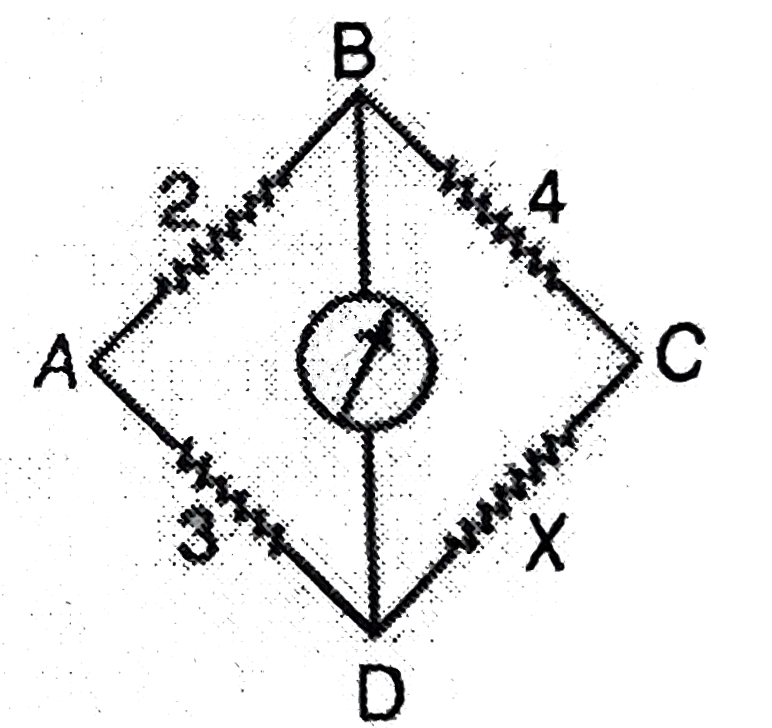A tangent galvanometer of resistance 10Ω shows a deflection of 60∘ when inserted in a circuit whose total resistance (including that of the galvanometer) is 100Ω. What shunt must be used to reduce the deflection to 30∘?
The correct Answer is:4.5Ω
Step by step video, text & image solution for A tangent galvanometer of resistance 10Omega shows a deflection of 60^(@) when inserted in a circuit whose total resistance (including that of the galvanometer) is 100Omega. What shunt must be used to reduce the deflection to 30^(@)? by Physics experts to help you in doubts & scoring excellent marks in Class 12 exams.
Topper's Solved these Questions
- BOOK - NN GHOSHCHAPTER - GALVANOMETERS: AMMETER AND VOLTMETERSEXERCISE - Exercise32videos
GALVANOMETERS: AMMETER AND VOLTMETERS
- BOOK - NN GHOSHCHAPTER - FUNDAMENTAL OF CURRENT ELECTRICITYEXERCISE - Exercises45videos
FUNDAMENTAL OF CURRENT ELECTRICITY
- BOOK - NN GHOSHCHAPTER - GAUSS THEOREM AND ITS APPLICATIONEXERCISE - EXAMPLES(a)24videos
GAUSS THEOREM AND ITS APPLICATION
Similar Questions
A galvanometer coil of resistance 50Ω, show full deflection of 100μA . The shunt resistance to be added to the galvanometer, to work as an ammeter of range 10 mA is
View SolutionA galvanometer with a coil resistance of 100Ω shows a full-scale deflection when a current of 1 mA is passed through it. What is value of the resistance which can convert this galvanometer into an ammeter showing a full scale deflection for a current 10 A? A resistance of the required value is available but it will get burnt if the energy dissipated in it is greater then 1 W. Can it be used for the conversion of the galvanometer described above?
View Solution
Knowledge Check
- Question 1 - Select One or More
A galvanometer with a coil of resistance 50Ω shows full-scale deflection when 10 mA current passes through it.
AThe galvanometer can measure a maximum voltage of 0.5 V.B5 A current can be measured if a shunt of 0.1Ω is connected in parallel to it.CIt can be used as voltmeter to measure a voltage of 5 V if 450Ω resistance is connected in series with the coil of the galvanometer.DIt can be used as a voltmeter to measure a voltage of 50 V if 4,950Ω resistance is connected in series with the coil of the galvanometer. - Question 2 - Select One
A galvanometer of resistance 36Ω is changed into an ammeter by using a shunt of 4Ω. The fraction f of total current passing through the galvanometer is
A1/40B1/4C1/140D1/10 - Question 3 - Select One
Galvanometer of resistance 25Ω shows full deflection for current of 10 mA. The resistance required to convert it into 100 V range will be
A9975Ω in seriesB975Ω in seriesC10025Ω in parallelD10000Ω in parallel
A galvanometer of resistance 10Ω shows full scale deflection for current 100 mA. The resistance that needs to be connected in series with the galvanometer so that it can be used to measure potential difference in the range 0-100 V is (in Ohm):
View SolutionIf the deflection of galvanometer in Wheatstone circuit is zero, the value of resistance will be
 View Solution
View SolutionA gavanometer shows full-scale deflection for a current of 1mA. Resistance of the coil of the galvanometer is 100Ω. What shunt is required to convert it into an ammeter which can measure a current of 1A?
View SolutionThe deflection in a M.C.G. is reduced to half , when it is shunted with a 40Ω coil. The resistance of the galvanometer is
View SolutionThe deflection in a galvanometer decreases to 1/5th of the original deflectioon, if it is shunted by a resistance of 5Ω. The resistance of the galvanometer is
View Solution

